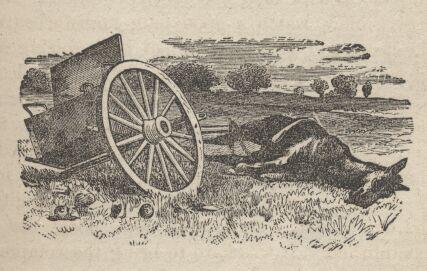Townley identifies Ragtown as a station between Old River and Desert Wells. Like other stations on the "Stillwater Dogleg," Ragtown probably functioned briefly as a Pony Express station in the summer and fall of 1861 and as an Overland Mail Company stage stop from 1861 to 1868. L. Kenyon and his family managed station operations at the site for nearly fifty years. The station's name supposedly came from the common site of freshly washed travelers' clothing spread out to dry on surrounding bushes.
In 1854, A. L. Kenyon established a trading post on his ranch at Ragtown, on the path of the California Trail. He dug a well 11 miles to the north, and is credited with saving the lives of many immigrants coming across the Forty Mile Desert. This would place the well, presumably, on or near the California trail somewhere near the Upsal Hogback. Temporary pole and canvas dwellings and stores were thrown up on this site in the late 1850's to take advantage of emigrant traffic. In 1861 Ragtown became a station on the Overland Mail and Stage route. Sam Clemens- better known as Mark Twain- passed through in that year. The rival Community of Centerville sprung up one and a half miles to the north, boasting of a hotel and a ranch.
In 1862 Ragtown experienced a flood, which disturbed many of the emigrant graves. In 1863 Ragtown became an important stop on the road to the Reese River mining area, but with the arrival of the Central Pacific Railroad its importance diminished somewhat. A post office finally opened in 1864, only to close in 1867. The 1880 census lists A.L. Kenyon as "stock raiser" and his wife Kate as "station keeper." It opened again in 1884 until 1887, after which mail was sent to the St. Clair post office. A farming community developed, and was known as Leeteville. Nevada Post Offices claims that Leeteville post office was in operation from 1895 until 1907, after which the mail went to Hazen.
We won't even go into the old story that Ragtown got its name from all the clothes drying on the bushes. Everyone has heard it before. Suffice to say, after crossing the forty mile desert and almost dying of thirst, Ragtown looked mighty fine in them there days.
(Forgotten Nevada)
"On the nineteenth day we crossed the Great American Desert—forty memorable miles of bottomless sand, into which the coach wheels sunk from six inches to a foot. We worked our passage most of the way across. That is to say, we got out and walked. It was a dreary pull and a long and thirsty one, for we had no water. From one extremity of this desert to the other, the road was white with the bones of oxen and horses. It would hardly be an exaggeration to say that we could have walked the forty miles and set our feet on a bone at every step! The desert was one prodigious graveyard. And the log-chains, wagon tyres, and rotting wrecks of vehicles were almost as thick as the bones. I think we saw log-chains enough rusting there in the desert, to reach across any State in the Union. Do not these relics suggest something of an idea of the fearful suffering and privation the early emigrants to California endured?
At the border of the Desert lies Carson Lake, or The “Sink” of the Carson, a shallow, melancholy sheet of water some eighty or a hundred miles in circumference. Carson River empties into it and is lost—sinks mysteriously into the earth and never appears in the light of the sun again—for the lake has no outlet whatever.
There are several rivers in Nevada, and they all have this mysterious fate. They end in various lakes or “sinks,” and that is the last of them. Carson Lake, Humboldt Lake, Walker Lake, Mono Lake, are all great sheets of water without any visible outlet. Water is always flowing into them; none is ever seen to flow out of them, and yet they remain always level full, neither receding nor overflowing. What they do with their surplus is only known to the Creator.
On the western verge of the Desert we halted a moment at Ragtown. It consisted of one log house and is not set down on the map."
